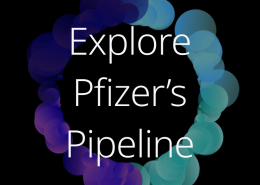Data Published in New England Journal of Medicine Shows Pfizer’s Tofacitinib Meets Primary Endpoint in Brazilian Study in Patients Hospitalized with COVID-19 Pneumonia
- Trial demonstrates cumulative incidence of death or respiratory failure through day 28 was 18.1% (26 of 144) with tofacitinib compared to 29.0% (42 of 145) with placebo, in hospitalized patients with COVID-19 pneumonia
- Multi-center, randomized, double-blind, placebo-controlled trial conducted across 15 sites in Brazil
- Tofacitinib is not approved or authorized for the treatment of COVID-19 patients. Tofacitinib should not be used in patients with an active serious infection
NEW YORK--(BUSINESS WIRE)-- Pfizer Inc. (NYSE: PFE) and The Academic Research Organization (ARO) from the Hospital Israelita Albert Einstein today announced that the New England Journal of Medicine has published positive findings from the STOP-COVID study (NCT04469114) evaluating the efficacy and safety of oral Janus kinase (JAK) inhibitor tofacitinib in 289 hospitalized adult patients with COVID-19 pneumonia who were not on ventilation.
The trial was a research collaboration between Pfizer and the ARO from the Hospital Israelita Albert Einstein in Sao Paulo, Brazil, which was the trial coordinating center. It is important to note that tofacitinib has not been approved or authorized for use by any regulatory authority worldwide for the treatment of COVID-19 and tofacitinib should not be used in patients with an active serious infection.
The trial demonstrated a lower cumulative incidence of death or respiratory failure through day 28 – the primary outcome of the study – with tofacitinib (18.1%) compared to placebo (29.0%) (risk ratio 0.63; 95% confidence interval [CI], 0.41 to 0.97; p=0.04). Death from any cause through day 28 occurred in 2.8% of patients in the tofacitinib group and in 5.5% in the placebo group (hazard ratio 0.49; 95% CI, 0.15 to 1.63).
Serious adverse events occurred in 20 patients (14.1%) in the tofacitinib group and 17 (12.0%) in the placebo group. Among protocol-specified adverse events of special interest, deep vein thrombosis, acute myocardial infarction, ventricular tachycardia, and myocarditis occurred in one patient each in the tofacitinib group; hemorrhagic stroke and cardiogenic shock occurred in one patient each in the placebo group. The incidence of serious infection was 3.5% in the tofacitinib group and 4.2% in the placebo group.
“We are encouraged by the initial findings of our randomized trial of tofacitinib in patients hospitalized with COVID-19 pneumonia. These results provide new information which indicates that the use of tofacitinib when added to standard of care, which includes glucocorticoids, may further reduce the risk of death or respiratory failure in this patient population,” said Otavio Berwanger, M.D., Ph.D., Director of the Academic Research Organization, Hospital Israelita Albert Einstein. “The study builds on the hypothesis that JAK inhibition could mitigate systemic and alveolar inflammation in patients with COVID-19-related pneumonia.”
“To effectively combat the COVID-19 pandemic, there remains a critical need for multiple therapeutic options to treat patients who have contracted the virus,” said Tamas Koncz, M.D., Ph.D., Chief Medical Officer, Pfizer Inflammation & Immunology. “As outlined in Pfizer’s five-point plan at the onset of the COVID-19 pandemic, we are keenly focused on working across the healthcare ecosystem with partners like Hospital Israelita Albert Einstein. We look forward to our continued collaboration as we analyze the full dataset from this study and assess next steps.”
The multi-center, randomized, double-blind, placebo-controlled trial included adult patients hospitalized with COVID-19 pneumonia receiving standard of care. Patients were randomized in a 1:1 ratio to receive either tofacitinib 10 mg twice daily plus standard of care or placebo twice daily plus standard of care for up to 14 days or until hospital discharge. Overall, 89.3% used glucocorticoids during hospitalization, predominantly dexamethasone.
For additional information about the study (NCT04469114), please visit https://www.clinicaltrials.gov.
About XELJANZ® (tofacitinib)
XELJANZ® (tofacitinib) isapproved in the U.S. in four indications: adults with moderately to severely active rheumatoid arthritis (RA) after methotrexate failure, adults with active psoriatic arthritis (PsA) after disease modifying antirheumatic drug (DMARD) failure, adults with moderately to severely active ulcerative colitis (UC) after tumor necrosis factor inhibitor (TNFi) failure and patients 2 years of age or older with active polyarticular course juvenile idiopathic arthritis (pcJIA). See Limitations of Use below.
XELJANZ has been studied in more than 50 clinical trials worldwide, including more than 20 trials in RA patients, and prescribed to over 300,000 adult patients (the majority of whom were RA patients) worldwide since 2012.i,ii,iii As the developer of tofacitinib, Pfizer is committed to advancing the science of JAK inhibition and enhancing understanding of tofacitinib through robust clinical development programs in the treatment of immune-mediated inflammatory conditions.
Pfizer recently communicated an increased rate of major adverse cardiovascular events (MACE) and malignancies (excluding non-melanoma skin cancer (NMSC)) for XELJANZ relative to anti-TNF therapy in RA patients who were 50 years of age or older and had at least one additional cardiovascular (CV) risk factor. Pfizer is continuing to work with the U.S. Food and Drug Administration (FDA), European Medicines Agency (EMA), and other regulatory agencies to review the full results and analysis.
INDICATIONS
Rheumatoid Arthritis
- XELJANZ/XELJANZ XR (tofacitinib) is indicated for the treatment of adult patients with moderately to severely active rheumatoid arthritis who have had an inadequate response or intolerance to methotrexate.
- Limitations of Use: Use of XELJANZ/XELJANZ XR in combination with biologic DMARDs or with potent immunosuppressants such as azathioprine and cyclosporine is not recommended.
Psoriatic Arthritis
- XELJANZ/XELJANZ XR (tofacitinib) is indicated for the treatment of adult patients with active psoriatic arthritis who have had an inadequate response or intolerance to methotrexate or other disease-modifying antirheumatic drugs (DMARDs).
- Limitations of Use: Use of XELJANZ/XELJANZ XR in combination with biologic DMARDs or with potent immunosuppressants such as azathioprine and cyclosporine is not recommended.
Ulcerative Colitis
- XELJANZ is indicated for the treatment of adult patients with moderately to severely active ulcerative colitis (UC), who have had an inadequate response or who are intolerant to TNF blockers.
- Limitations of Use: Use of XELJANZ in combination with biological therapies for UC or with potent immunosuppressants such as azathioprine and cyclosporine is not recommended.
Polyarticular Course Juvenile Idiopathic Arthritis
- XELJANZ/XELJANZ Oral Solution is indicated for the treatment of active polyarticular course juvenile idiopathic arthritis (pcJIA) in patients 2 years of age and older.
- Limitations of Use: Use of XELJANZ/XELJANZ Oral Solution in combination with biologic DMARDs or potent immunosuppressants such as azathioprine and cyclosporine is not recommended.
It is important to note that a dosage of Xeljanz 10 mg twice daily is not recommended for the treatment of rheumatoid arthritis, psoriatic arthritis, or polyarticular course juvenile idiopathic arthritis.
IMPORTANT SAFETY INFORMATION
SERIOUS INFECTIONS
Patients treated with XELJANZ* are at increased risk for developing serious infections that may lead to hospitalization or death. Most patients who developed these infections were taking concomitant immunosuppressants, such as methotrexate or corticosteroids.
If a serious infection develops, interrupt XELJANZ until the infection is controlled.
Reported infections include:
- Active tuberculosis, which may present with pulmonary or extrapulmonary disease. Patients should be tested for latent tuberculosis before XELJANZ use and during therapy. Treatment for latent infection should be initiated prior to XELJANZ use.
- Invasive fungal infections, including cryptococcosis and pneumocystosis. Patients with invasive fungal infections may present with disseminated, rather than localized, disease.
- Bacterial, viral, including herpes zoster, and other infections due to opportunistic pathogens.
The most common serious infections reported with XELJANZ included pneumonia, cellulitis, herpes zoster, urinary tract infection, diverticulitis, and appendicitis. Avoid use of XELJANZ in patients with an active, serious infection, including localized infections, or with chronic or recurrent infection.
In the UC* population, XELJANZ 10 mg twice daily was associated with greater risk of serious infections compared to 5 mg twice daily. Opportunistic herpes zoster infections (including meningoencephalitis, ophthalmologic, and disseminated cutaneous) were seen in patients who were treated with XELJANZ 10 mg twice daily.
The risks and benefits of treatment with XELJANZ should be carefully considered prior to initiating therapy in patients with chronic or recurrent infection, or those who have lived or traveled in areas of endemic TB or mycoses. Viral reactivation including herpes virus and hepatitis B reactivation have been reported. Screening for viral hepatitis should be performed in accordance with clinical guidelines before starting therapy.
Patients should be closely monitored for the development of signs and symptoms of infection during and after treatment with XELJANZ, including the possible development of tuberculosis in patients who tested negative for latent tuberculosis infection prior to initiating therapy.
Caution is also recommended in patients with a history of chronic lung disease, or in those who develop interstitial lung disease, as they may be more prone to infection.
MORTALITY
Rheumatoid arthritis (RA)† patients 50 years of age and older with at least one cardiovascular (CV) risk factor treated with XELJANZ 10 mg twice a day had a higher rate of all-cause mortality, including sudden CV death, compared to those treated with XELJANZ 5 mg given twice daily or TNF blockers in a large, ongoing, postmarketing safety study. XELJANZ 10 mg twice daily or XELJANZ XR 22 mg once daily is not recommended for the treatment of RA or PsA‡. For UC, use XELJANZ at the lowest effective dose and for the shortest duration needed to achieve/maintain therapeutic response.
MALIGNANCIES
Lymphoma and other malignancies have been observed in patients treated with XELJANZ. Epstein Barr Virus-associated post-transplant lymphoproliferative disorder has been observed at an increased rate in renal transplant patients treated with XELJANZ and concomitant immunosuppressive medications.
Consider the risks and benefits of XELJANZ treatment prior to initiating therapy in patients with a known malignancy other than a successfully treated non-melanoma skin cancer (NMSC) or when considering continuing XELJANZ in patients who develop a malignancy.
Malignancies (including solid cancers and lymphomas) were observed more often in patients treated with XELJANZ 10 mg twice daily dosing in the UC long-term extension study.
Other malignancies were observed in clinical studies and the post-marketing setting including, but not limited to, lung cancer, breast cancer, melanoma, prostate cancer, and pancreatic cancer. NMSCs have been reported in patients treated with XELJANZ. In the UC population, treatment with XELJANZ 10 mg twice daily was associated with greater risk of NMSC. Periodic skin examination is recommended for patients who are at increased risk for skin cancer.
THROMBOSIS
Thrombosis, including pulmonary embolism, deep venous thrombosis, and arterial thrombosis, have occurred in patients treated with XELJANZ and other Janus kinase inhibitors used to treat inflammatory conditions. RA patients who were 50 years of age and older with at least one CV risk factor treated with XELJANZ 10 mg twice daily compared to XELJANZ 5 mg twice daily or TNF blockers in a large, ongoing postmarketing safety study had an observed increase in incidence of these events. Many of these events were serious and some resulted in death. Avoid XELJANZ in patients at risk. Discontinue XELJANZ and promptly evaluate patients with symptoms of thrombosis. For patients with UC, use XELJANZ at the lowest effective dose and for the shortest duration needed to achieve/maintain therapeutic response. XELJANZ 10 mg twice daily or XELJANZ XR 22 mg once daily is not recommended for the treatment of RA or PsA. In a long-term extension study in UC, four cases of pulmonary embolism were reported in patients taking XELJANZ 10 mg twice daily, including one death in a patient with advanced cancer.
GASTROINTESTINAL PERFORATIONS
Gastrointestinal perforations have been reported in XELJANZ clinical trials, although the role of JAK inhibition is not known. In these studies, many patients with rheumatoid arthritis were receiving background therapy with Nonsteroidal Anti-Inflammatory Drugs (NSAIDs). There was no discernable difference in frequency of gastrointestinal perforation between the placebo and the XELJANZ arms in clinical trials of patients with UC, and many of them were receiving background corticosteroids. XELJANZ should be used with caution in patients who may be at increased risk for gastrointestinal perforation (e.g., patients with a history of diverticulitis or taking NSAIDs).
HYPERSENSITIVITY
Angioedema and urticaria that may reflect drug hypersensitivity have been observed in patients receiving XELJANZ and some events were serious. If a serious hypersensitivity reaction occurs, promptly discontinue tofacitinib while evaluating the potential cause or causes of the reaction.
LABORATORY ABNORMALITIES
Lymphocyte Abnormalities: Treatment with XELJANZ was associated with initial lymphocytosis at one month of exposure followed by a gradual decrease in mean lymphocyte counts. Avoid initiation of XELJANZ treatment in patients with a count less than 500 cells/mm3. In patients who develop a confirmed absolute lymphocyte count less than 500 cells/mm3, treatment with XELJANZ is not recommended. Risk of infection may be higher with increasing degrees of lymphopenia and consideration should be given to lymphocyte counts when assessing individual patient risk of infection. Monitor lymphocyte counts at baseline and every 3 months thereafter.
Neutropenia: Treatment with XELJANZ was associated with an increased incidence of neutropenia (less than 2000 cells/mm3) compared to placebo. Avoid initiation of XELJANZ treatment in patients with an ANC less than 1000 cells/mm3. For patients who develop a persistent ANC of 500-1000 cells/mm3, interrupt XELJANZ dosing until ANC is greater than or equal to 1000 cells/mm3. In patients who develop an ANC less than 500 cells/mm3, treatment with XELJANZ is not recommended. Monitor neutrophil counts at baseline and after 4-8 weeks of treatment and every 3 months thereafter.
Anemia: Avoid initiation of XELJANZ treatment in patients with a hemoglobin level less than 9 g/dL. Treatment with XELJANZ should be interrupted in patients who develop hemoglobin levels less than 8 g/dL or whose hemoglobin level drops greater than 2 g/dL on treatment. Monitor hemoglobin at baseline and after 4-8 weeks of treatment and every 3 months thereafter.
Liver Enzyme Elevations: Treatment with XELJANZ was associated with an increased incidence of liver enzyme elevation compared to placebo. Most of these abnormalities occurred in studies with background DMARD (primarily methotrexate) therapy. If drug-induced liver injury is suspected, the administration of XELJANZ should be interrupted until this diagnosis has been excluded. Routine monitoring of liver tests and prompt investigation of the causes of liver enzyme elevations is recommended to identify potential cases of drug-induced liver injury.
Lipid Elevations: Treatment with XELJANZ was associated with dose-dependent increases in lipid parameters, including total cholesterol, low-density lipoprotein (LDL) cholesterol, and high-density lipoprotein (HDL) cholesterol. Maximum effects were generally observed within 6 weeks. There were no clinically relevant changes in LDL/HDL cholesterol ratios. Manage patients with hyperlipidemia according to clinical guidelines. Assessment of lipid parameters should be performed approximately 4-8 weeks following initiation of XELJANZ therapy.
VACCINATIONS
Avoid use of live vaccines concurrently with XELJANZ. The interval between live vaccinations and initiation of tofacitinib therapy should be in accordance with current vaccination guidelines regarding immunosuppressive agents. Update immunizations in agreement with current immunization guidelines prior to initiating XELJANZ therapy.
PATIENTS WITH GASTROINTESTINAL NARROWING
Caution should be used when administering XELJANZ XR to patients with pre-existing severe gastrointestinal narrowing. There have been rare reports of obstructive symptoms in patients with known strictures in association with the ingestion of other drugs utilizing a non-deformable extended release formulation.
HEPATIC and RENAL IMPAIRMENT
Use of XELJANZ in patients with severe hepatic impairment is not recommended.
For patients with moderate hepatic impairment or with moderate or severe renal impairment taking XELJANZ 5 mg twice daily, reduce to XELJANZ 5 mg once daily.
For UC patients with moderate hepatic impairment or with moderate or severe renal impairment taking XELJANZ 10 mg twice daily, reduce to XELJANZ 5 mg twice daily.
ADVERSE REACTIONS
The most common serious adverse reactions were serious infections. The most commonly reported adverse reactions during the first 3 months in controlled clinical trials in patients with RA with XELJANZ 5 mg twice daily and placebo, respectively, (occurring in greater than or equal to 2% of patients treated with XELJANZ with or without DMARDs) were upper respiratory tract infection, nasopharyngitis, diarrhea, headache, and hypertension. The safety profile observed in patients with active PsA treated with XELJANZ was consistent with the safety profile observed in RA patients.
Adverse reactions reported in ≥5% of patients treated with either 5 mg or 10 mg twice daily of XELJANZ and ≥1% greater than reported in patients receiving placebo in either the induction or maintenance clinical trials for UC were: nasopharyngitis, elevated cholesterol levels, headache, upper respiratory tract infection, increased blood creatine phosphokinase, rash, diarrhea, and herpes zoster.
USE IN PREGNANCY
Available data with XELJANZ use in pregnant women are insufficient to establish a drug associated risk of major birth defects, miscarriage or adverse maternal or fetal outcomes. There are risks to the mother and the fetus associated with rheumatoid arthritis and UC in pregnancy. In animal studies, tofacitinib at 6.3 times the maximum recommended dose of 10 mg twice daily demonstrated adverse embryo-fetal findings. The relevance of these findings to women of childbearing potential is uncertain. Consider pregnancy planning and prevention for females of reproductive potential.
* Unless otherwise stated, “XELJANZ” in the Important Safety Information refers to XELJANZ, XELJANZ XR, and XELJANZ Oral Solution.
†UC = ulcerative colitis. XELJANZ/XELJANZ XR is indicated for the treatment of adult patients with moderately to severely active UC, who have had an inadequate response or who are intolerant to TNF blockers. Limitations of Use: Use of XELJANZ/XELJANZ XR in combination with biological therapies for UC or with potent immunosuppressants such as azathioprine and cyclosporine is not recommended.
‡RA = rheumatoid arthritis. XELJANZ/XELJANZ XR is indicated for the treatment of adult patients with moderately to severely active rheumatoid arthritis who have had an inadequate response or intolerance to methotrexate. Limitations of Use: Use of XELJANZ/XELJANZ XR in combination with biologic DMARDs or with potent immunosuppressants such as azathioprine and cyclosporine is not recommended. XELJANZ 10 mg twice daily is not approved for use in RA.
§PsA = psoriatic arthritis. XELJANZ/XELJANZ XR is indicated for the treatment of adult patients with active psoriatic arthritis who have had an inadequate response or intolerance to methotrexate or other disease-modifying antirheumatic drugs (DMARDs). Limitations of Use: Use of XELJANZ/XELJANZ XR in combination with biologic DMARDs or with potent immunosuppressants such as azathioprine and cyclosporine is not recommended. XELJANZ 10 mg twice daily is not approved for use in PsA.
Please see full Prescribing Information, including BOXED WARNING for XELJANZ/XELJANZ XR available at: www.xeljanzpi.com.
Pfizer Inc.: Breakthroughs that change patients’ lives®
At Pfizer, we apply science and our global resources to bring therapies to people that extend and significantly improve their lives. We strive to set the standard for quality, safety and value in the discovery, development and manufacture of health care products, including innovative medicines and vaccines. Every day, Pfizer colleagues work across developed and emerging markets to advance wellness, prevention, treatments and cures that challenge the most feared diseases of our time. Consistent with our responsibility as one of the world's premier innovative biopharmaceutical companies, we collaborate with health care providers, governments and local communities to support and expand access to reliable, affordable health care around the world. For more than 150 years, we have worked to make a difference for all who rely on us. We routinely post information that may be important to investors on our website at www.pfizer.com. In addition, to learn more, please visit us on www.pfizer.com and follow us on Twitter at @Pfizer and @Pfizer_News, LinkedIn, YouTube and like us on Facebook at Facebook.com/Pfizer.
DISCLOSURE NOTICE: The information contained in this release is as of June 16, 2021. Pfizer assumes no obligation to update forward-looking statements contained in this release as the result of new information or future events or developments.
This release contains forward-looking information about XELJANZ (tofacitinib) and a study evaluating the efficacy and safety of tofacitinib in hospitalized adult patients with COVID-19 pneumonia, including their potential benefits, that involves substantial risks and uncertainties that could cause actual results to differ materially from those expressed or implied by such statements. Risks and uncertainties include, among other things, the uncertainties inherent in research and development, including the ability to meet anticipated clinical endpoints, commencement and/or completion dates for our clinical trials, regulatory submission dates, regulatory approval dates and/or launch dates, as well as the possibility of unfavorable new clinical data and further analyses of existing clinical data; the risk that clinical trial data are subject to differing interpretations and assessments by regulatory authorities; whether regulatory authorities will be satisfied with the design of and results from our clinical studies; uncertainties regarding the commercial success of XELJANZ and XELJANZ XR; whether and when any applications for tofacitinib for hospitalized patients with COVID-19 pneumonia will be filed in any jurisdictions and whether and when any applications for tofacitinib for any other indications may be filed in any jurisdictions; whether and when any applications that may be pending or filed for any potential indications for tofacitinib in any jurisdictions may be approved by regulatory authorities, which will depend on myriad factors, including making a determination as to whether the product’s benefits outweigh its known risks and determination of the product’s efficacy, and, if approved, whether they will be commercially successful; uncertainties regarding the commercial impact of or the results of clinical trial A3921133 or any potential actions by regulatory authorities based on analysis of clinical trial A3921133 or other data, which will depend, in part, on labeling determinations; decisions by regulatory authorities impacting labeling, manufacturing processes, safety and/or other matters that could affect the availability or commercial potential of XELJANZ and XELJANZ XR; uncertainties regarding the impact of COVID-19 on our business, operations and financial results; and competitive developments.
A further description of risks and uncertainties can be found in Pfizer’s Annual Report on Form 10-K for the fiscal year ended December 31, 2020 and in its subsequent reports on Form 10-Q, including in the sections thereof captioned “Risk Factors” and “Forward-Looking Information and Factors That May Affect Future Results”, as well as in its subsequent reports on Form 8-K, all of which are filed with the U.S. Securities and Exchange Commission and available at www.sec.gov and www.pfizer.com.
________________________________
i Pfizer Data on File. XELJANZ Worldwide Registration Status.
iiClinicalTrials.gov. Tofacitinib RA Studies. Accessed June 2021. https://clinicaltrials.gov/ct2/results?term=tofacitinib%2C+rheumatoid+arthritis%2C+ORAL&type=&rslt=&recr=&age_v=&gndr=&cond=Rheumatoid+Arthritis&intr=&titles=&outc=&spons=&lead=&id=&state1=&cntry1=&state2=&cntry2=&state3=&cntry3=&locn=&rcv_s=&rcv_e=&lup_s=&lup_e=
iii Pfizer. Data on File. June 2021
View source version on businesswire.com: https://www.businesswire.com/news/home/20210616005998/en/
Media Contact:
Steve Danehy
+1 212-733-1538
[email protected]
Investor Contact:
Chuck Triano
+1 212-733-3901
[email protected]
Source: Pfizer Inc.







